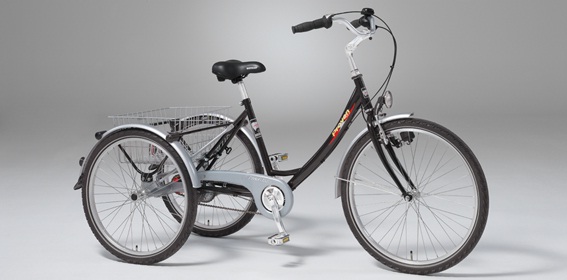
NATO and CYCLE Logistics: An Unexpected yet Happy Marriage
Is one of the world’s largest inter-governmental military alliances running on pedal power?
NATO’s headquarters in Belgium and its 5000 international civilian staff play a mammoth role in its policy planning of operations and capabilities. As budgets are tightened, there’s little doubt that NATO is looking to find innovative ways make operations more efficient. CYCLE Logistics has discovered that NATO HQ has been using bikes for the last few years. Mr. Marc Reulmonde, the Logistics Coordinator at NATO HQ in Brussels, told us why he has taken a rather unorthodox approach to logistics in the military world.
“We started to use trikes about 3 years ago” he says, when it was clear that there was a lot more distance to be covered between the various buildings. NATO is in the middle of building a new campus across the street from their current location. “Now we have 6. They are very easy to use. They are used by all different levels of staff. They are available for whoever needs them, including VIPs. If they need to go someplace, they just take it and go.” The trikes are from Pfau-Tek, a German producer. The supplier is in Bruges, and NATO paid about €750 per trike.
“There is a basket behind the seat, about 60X40X40 cm. It will hold 60-70 kg.” Reulmond tells me that the baskets are used to carry laptops, folders, papers and small goods and sometime they’re even used for desktop PCs, phones and IT equipment.”
There is from 100 to 600 meters between some of the buildings. “I ride my trike 4 to 5 km every day.” “It’s very cost effective. I save a lot of time. I would lose 2-3 hours every day if I had to walk instead. ”
“They are heavy trikes and that has some important consequences. They can’t race. You can go a maximum of about 20kph. And you can’t steal it because of the weight.” Reulmonde mentioned this repeatedly. Theft is clearly a big issue. “There are 5000 people here. So some things disappear. When we used bikes in the past they disappeared.” But not the trikes. In the 3 years of service, none have been stolen.
“The trikes are not locked by the users; they are available for everybody to use at any time 24/7. We can’t do that with everything.”
Reulmonde says that he does lock up his trike because he needs to use it all day long. If he doesn’t lock it, then someone else will use it. While being safe to use on the NATO campus but Reulmonde doesn’t think they’d be good on the roads because they have a wide wheelbase.
I was particularly curious why NATO, which makes most people think of high tech gadgets, was using trikes. Why not Segways or electric bikes?
“We have 2 Segways – but we have to keep charging them. We have to keep them locked up. And we can’t recommend that people carry anything like a laptop when they are using them. The trikes we leave available day and night. We don’t have to charge them. They are never stolen.”
“We get a lot of jokes about using the trikes,” because they are low tech. But they are so popular that Reulmonde could not imagine doing his job without them.
“Who made the decision to try to use them?” I asked him. “I was the one,” says Reulmonde with quiet pride.
Reulemonde initially had but one trike, but they’ve become too popular, he soon purchased a second. There’s another two planned for next year’s budget, and it looks like there’ll be many more to follow.
This shift towards more efficient forms of logistics is timely. NATO’s new headquarters in Brussels, which should be finished in 2015, are expected to cost €1 billion. Jim Murphy, the shadow defense secretary in the UK, stated in the Telegraph earlier on this year: “A lot of eyebrows will be raised and the government must be clearer that this is value for money for British taxpayers.”
As NATO, like many supra-nation bodies, face increased scrutiny on the home front when it comes to expenditure, opting for cheaper, more efficient forms of logistics are a win-win for everyone involved.
About the Author
Randy Rzewnicki has a wealth of experience in the world of Cycling having previously worked with Fietsersbond Brussels (Brussel’s cyclist Union) and a range of other EU funded Projects such as Life-Cycle. He is currently co-managing the Cycle Logistics Project, which is pushing for behavioral change by informing people how to use their bicycle to transport goods usually moved by cars.
About Cycle Logistics
Running from May 2011 to 2014 and spanning across 8-12 countries, the project will achieve a concrete reduction in energy used for urban freight transport. This will be accomplished through intra-urban final delivery of goods by bicycle rather than motorized vehicles, using expert know-how from existing cycle logistic companies and inciting policy interventions across Europe. CYCLE Logistics aims to save 1300 tons of fuel and 3500 t/CO2, have 2000 new cargo bikes in use in European urban areas and see at least 10,000 trips shifted to intermodal transport chains.
The CYCLE logistics team are meeting this week in the cycling city of Ferrara, Italy. They have heard how one partner, OUTSPOKEN DELIVERY, reports saving 14 tonnes of CO2 per year by replacing mini-vans with cargo bike deliveries in Cambridge UK. “We’re also looking at supplementing the services of the major delivery companies since motorized vehicles cant access parts of Cambridge after 10 AM. We can, we’re quick, quiet, and no carbon footprint,” said their CEO.
You can follow Cycle Logistics on Twitter: @cyclelogistics.
Contact the author
Recent news!
Upcoming events
Contact Us
Avenue des Arts, 7-8
Postal address: Rue de la Charité, 22
1210 Brussels, Belgium











